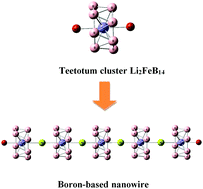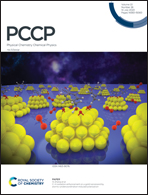The teetotum cluster Li2FeB14 and its possible use for constructing boron nanowires†
Abstract
Systematic density functional theory (DFT) calculations using the TPSSh functional and the def2-TZVP basis set were carried out to identify the global energy minimum structure of the Li2FeB14 cluster. Keeping the double ring tubular shape of FeB14, capping of two Li atoms leads to a teetotum form at a low spin state, in which the Fe atom is endohedrally covered by two B7 strings, and both Li atoms are attached to Fe along the C7 axis at both sides. Calculated results show that strong electrostatic interactions between 2Li+ and Fe2− arising from Li electron transfer upon doping particularly provide a key driving force for stabilizing this charge-transfer structure. The bonding pattern of the teetotum can be understood from the hollow cylinder model (HCM). TD-DFT calculations demonstrate that this cluster can also be regarded as a useful material for transparent optoelectronic devices. Furthermore, the Li2FeB14 superatom can be used as a building block for making boron-based nanowires with metallic character. Replacement of Li atoms by Mg atoms was also found to lead to nanowires.



 Please wait while we load your content...
Please wait while we load your content...